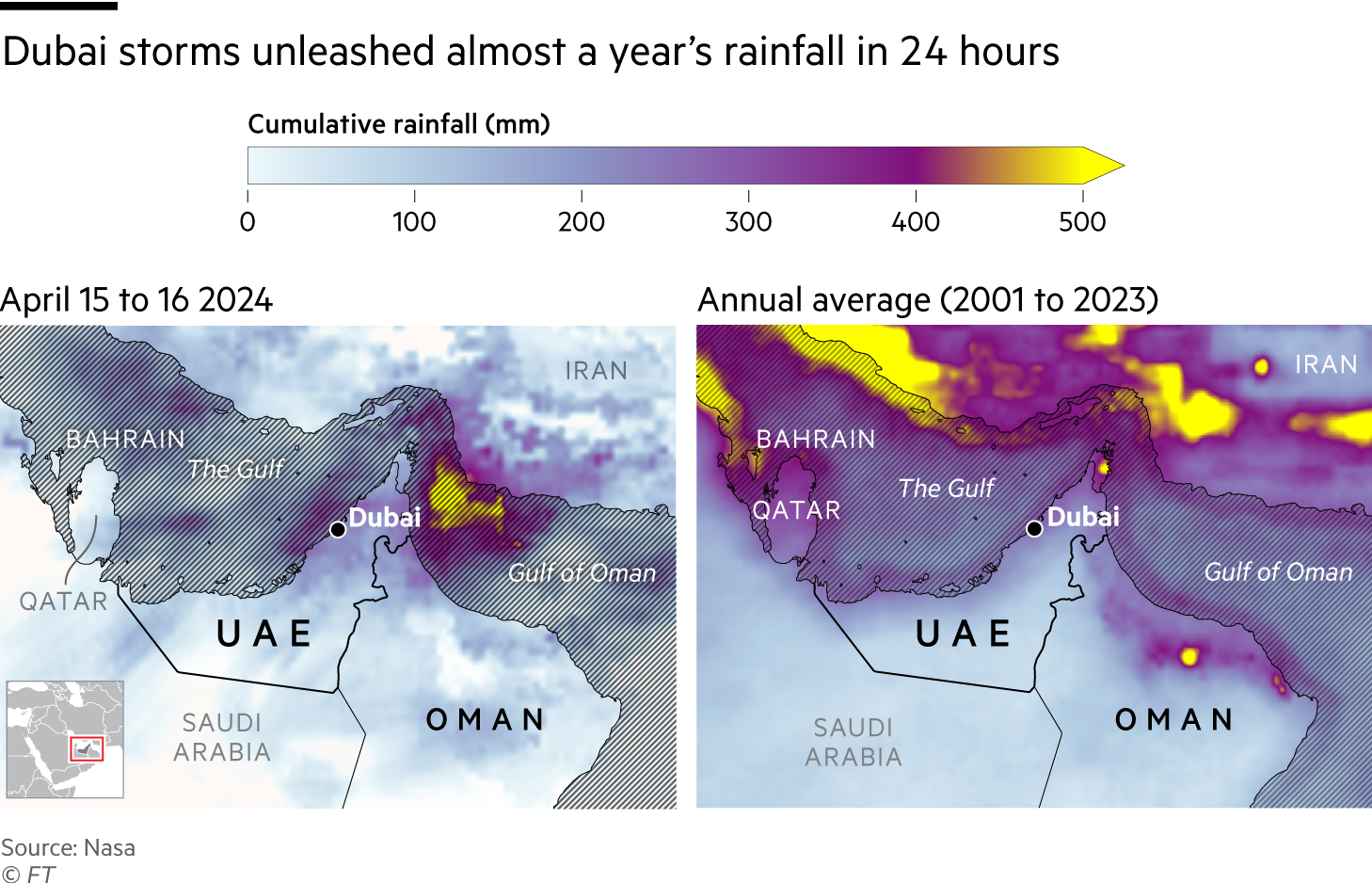Visitors to Dubai’s Mall of the Emirates’ famous artificial ski slope last week found it dark and deserted. Even though the shopping centre itself was filled with the usual tourists, the silent snow dome suggested all was not well, after a deluge in the metropolis disrupted the power to chill the slope.
Several days after the United Arab Emirates was drenched by historically intense rainfall, many streets surrounding the pristine mall were covered by water.
Abandoned cars, including a Porsche Carrera, littered nearby roads. Local residents, whose buildings still had no power or running water, crouched by the mall’s power sockets and washed in its public toilets.
The disruption in the wake of the dramatic storm, which caused flash flooding across the oil-exporting country, brought home the growing threat of intensifying weather events to the desert nation’s infrastructure.
Many services have returned to normal. But water was still standing in some areas more than a week after the storm and the UAE issued health advice about the stagnant pools, which have turned foul smelling. Dubai’s rulers have pledged to spend Dh2bn ($545mn) on patching up damage.
“Traditionally Dubai and the UAE have not had to worry about getting too much rain, so it hasn’t been part of their planning calculus,” said an expert on climate resilience and urban environments who works with Middle East governments. “That will have to change”.
“You would not think, being here, setting up a store, you have to think: waterproofing,” said Somia Anwar, co-owner of Bookends, a used books seller. As water gushed into their basement-level shop last week, “I felt like I was in the Titanic”. After the water was pumped out, Anwar had to dispose of 10,000 books spoiled by sewage water, which was not covered by insurance.
Scientists said heavy rainfall in years when the naturally occurring El Niño pattern warms the Pacific Ocean had become anywhere from 10 per cent to 40 per cent more severe, in a rapid study by the World Weather Attribution group.
While the researchers could not precisely determine how much of the increase in such wet weather was due to human-caused climate change, they found that warming caused by burning fossil fuels was the most likely explanation.
Not only does climate change mean the UAE has to contend with ever hotter summers as temperatures reach beyond 50C, it also faces the wetter weather fuelled by global warming.
Although the sudden rainfall was the heaviest since records began 75 years ago, according to meteorological authorities, it was just the most recent deluge. Inundation has become frequent enough that Dubai’s transport authority opened a flood management control centre in January.
“They are not rare events for the Middle East,” said Suzanne Gray, professor of meteorology and Reading University in the UK, who identified the tempest as being caused by an amalgamation of several high level thunderstorms, called a mesoscale convective system, typically hundreds of kilometres wide.
Scientists said that cloud seeding, a technique used by the UAE to help stimulate rain, was not to blame.

“We know that man-made climate increases extreme rainfall — this is well understood physics as warm air holds more water,” said John Marsham, Met Office joint chair at the University of Leeds. “Any possible effect of any cloud seeding in these circumstances would be tiny.”
With the UAE hosting the COP28 climate summit last year, awareness has grown about climate change dangers. The country has an adaptation plan, and Dubai was the first to apply for a UN scheme to become a “City Resilience Hub” in 2020.
UAE capital Abu Dhabi weathered the latest storm better than the larger glitzy trading and financial hub of Dubai. The futuristic city is the UAE’s biggest by population and the location of the world’s second busiest airport, which was forced to cancel more than 1,000 flights, leaving passengers stranded for days.
“The infrastructure was built before these weather changes happened,” said an insurance executive, who said it was too early to estimate overall damage costs. “In certain instances, the quality of construction by the developers was not good enough.”
Sprawling Dubai was especially vulnerable to flooding because it was relatively flat, covered in impermeable concrete and asphalt surfaces, and its desert sands lacked the ability to grow vegetation that could absorb floodwater, said a Dubai-based town planning specialist.

Underlying those drainage problems is a groundwater table already oversaturated by irrigation and pipe leakage, a common issue in the Gulf. “The cities are really floating,” said Hrvoje Cindrić, Middle East planning lead at international engineering firm Buro Happold.
When Dubai floods, he added, “the water has got nowhere to go”.
Dubai officials over the years have considered comprehensive drainage systems but carried out limited works because of the high costs involved versus the perceived relatively low risk.
Upgrades to the network have included a 10km drainage tunnel under southern Dubai, opened ahead of Expo 2020, to serve the huge exhibition facilities, which was also the site of the UN climate summit, and the airport.
“You wouldn’t engineer for the worst possible scenario . . . it’s prohibitively expensive,” said Huda Shaka, a chartered urban planner based in Dubai. But following the storm, “it’s not just a theoretical scenario. It has happened, and the costs are real.”

In the wake of the floods, Sheikh Hamdan bin Mohammed al-Maktoum, the crown prince, approved a Dh66bn upgrade to the drain network. Tenders were first issued last year for the project, though bids were not received until February.
The announcement came after the UAE president Sheikh Mohammed bin Zayed al-Nahyan ordered officials to monitor the nation’s infrastructure and “limit the damage caused,” according to the state news agency.
Town planning experts say Dubai could adopt “sponge city” principles, making detailed flooding plans and allotting areas with permeable surfaces for better drainage. Given the damage sustained by many buildings, “there may be a need for tougher building codes,” said a former Emirati official.
“Now the cost of mitigating [extreme weather] becomes not unreasonable,” said urban planner Shaka, adding: “sometimes it takes an extreme event for action to happen.”
Climate Capital

Where climate change meets business, markets and politics. Explore the FT’s coverage here.
Are you curious about the FT’s environmental sustainability commitments? Find out more about our science-based targets here
Read More: World News | Entertainment News | Celeb News
FT









